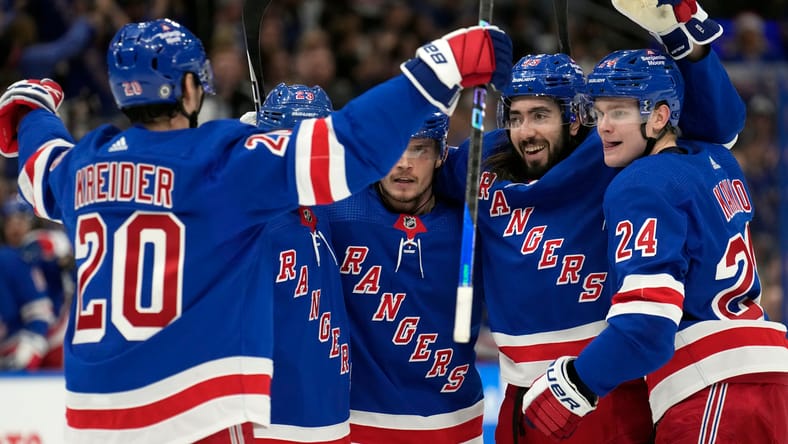
As the 2022-2023 NY Rangers solidify their roster and look to make a run at the Stanley Cup, comparisons to the 2013-2014 team that won the Eastern Conference are going to be made. That team was very good, deep, but lacked the star power to get them over the hump. This year’s version has that star power, but how do they compare to that 13-14 team?
Top line: Kreider-Stepan-Nash vs Kreider-Zibanejad-Tarasenko
Bear with me, as we assume that Vladimir Tarasenko will be on the top line for the sake of this post. In the regular season, the Kreider-Stepan-Nash line was criminally underrated. Per Tom Urtz, that line put up an absurd 68.28 GF% to go with a 56.41 CF% and a 55.55 xGF%. They had finish, they had puck control, and they had two way hockey.
But not one of them had 30 goals. The highest scorer on that line was Rick Nash with 26 goals. Derek Stepan had the most points with 57. Chris Kreider was a matchup nightmare, but only had 17 goals and 37 points.
The Kreider-Zibanejad-Tarasenko line doesn’t have enough games to give us legitimate GF%/CF%/xGF% splits, but the star power is unmatched. Tarasenko may be all offense, but he is balanced out by the solid two-way games of Kreider and Zibanejad. Zibanejad is a top-10 center in the game, something we couldn’t say about Stepan.
On paper, the star power of this year’s top line is far better than the Kreider-Stepan-Nash line. However, we will need to see how they mesh for the rest of the season.
Second line: Hagelin-Richards-Callahan/St. Louis vs. Panarin-Trocheck-Vesey
Let’s assume Hagelin and Vesey are a wash. It’s not an exact science, but it’s close enough with this year’s results. Brad Richards and Martin St. Louis were the star power on this line, but neither could do what Artemi Panarin can do. Panarin takes over games. As great as Richards and St. Louis were, Panarin is just on another level.
Top two lines pre trade were great too
455 minutes 5v5
Kreider-Stepan-Nash
68.28 GF% | 56.41 CF% | 55.55 xGF%300 minutes 5v5
Hagelin-Richards-Callahan
67.86 GF% | 52.9 CF% | 57.6 xGF%Good depth and balance is possible, you don't need to settle!
— Tom Urtz Jr. (@TomUrtzJr) February 23, 2023
The on-ice results of the 13-14 second line are hard to match. They were arguably more effective than the top line, which is saying something given that line’s absurd numbers. That line was nothing short of spectacular for the Rangers, and it wasn’t even their most dominant line.
But the 22-23 Rangers have found something close to it. Panarin-Trocheck-Vesey have nearly ridiculous splits of 70.00 GF% / 68.75 CF% / 73.76 xGF%. It’s only been 80 minutes for this trio, but if there is anything that screams “we don’t need Patrick Kane,” it’s this. Vesey is the perfect third for that line.
I guess we can call this comparison a wash for now?
Third line: Pouliot-Brassard-Zuccarello vs. Lafreniere-Chytil-Kakko
The third line is where Cup champions are made. All playoff teams have a good top six, although few have been as good as this year’s Rangers. Pouliot-Brassard-Zuccarello was the line that set the Rangers apart. As Tom noted above, that line had the best three way splits of all the lines that year, notably feasting on lesser competition.
The Kid Line, while inconsistent so far, have stepped it up recently. They too feast on lesser competition while the top six draw the tougher assignments. They currently have three way splits of 60.61 GF% / 51.85 CF% / 49.02 xGF% and rising fast. Much like in 13-14, few teams have the depth that can skate with this third line.
The Kid Line has the potential to be the difference maker in the playoffs for sure, but that Pouliot-Brassard-Zuccarello line was pure dominance.
We can give the edge to the 13-14 team here.
Fourth line: Boyle-Moore-Dorsett vs. (currently) Motte-Leschyshyn-Goodrow
The 13-14 team had the best fourth line in hockey that year. Even when Dorsett was hurt, they replaced him with equally effective and criminally underrated Daniel Carcillo. The fourth line thus far for the 22-23 team has been a black hole of bad, but that is in the process of being fixed. The Rangers sorely need a 4C to replace Jake Leschyshyn, and that appears to be what they are aiming to do.
The edge right now is to Boyle-Moore-Dorsett, but if the Rangers go something like Motte-Sam Lafferty-Goodrow, it could be just as good.
Defense pairs / Powerplay
If the forwards are more of a wash, and it appears that way, then why does the 22-23 team look so much better? The answer is simple, and it’s on the blue line. The 13-14 team’s leading scorer on the blue line was Dan Girardi with 24 points. Adam Fox and K’Andre Miller have already surpassed that mark, with Jacob Trouba on his way and possibly Braden Schneider as well. The difference is with Fox and Miller. What makes the 22-23 team so much more dangerous is points from the blue line and the ability to move the puck.
This obviously shows up on the powerplay as well, giving the 22-23 team the edge.
This is the clear advantage for the 22-23 team, aside from the star power difference. Overall the teams are certainly comparable, but the edge goes to this year’s team based on significant leaps forward on the blue line, powerplay, and in finishing ability.
Share:
More About:Musings
